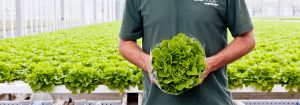This is part two of our series of articles on how LED grow lights can influence nitrate levels in leafy greens. There are advocates on both sides of the issue. Some people want to lower nitrate levels in vegetables, while others want to raise them. Philips lighting Research, HAS School for Agriculture and Wageningen University carried out three simultaneous trials and discovered they could decrease or increase nitrate levels in the plants.
The trials were carried out at the same time in winter, one in a greenhouse with HID toplighting, one in a greenhouse with LED toplighting and one in a city farm with LED lighting. The exact same crops of lettuce and the same fertiliser were used in all three trials. The crops in the city farm in particular had significantly lower levels of nitrates because they were grown consistently with the right amount of light every day.
The crops grown in the greenhouse under HID and LED both had higher levels of nitrate because they were affected by different climate conditions and lower light levels than optimum. The plants experienced cloudy, sunny, colder and warmer days, during which nitrates accumulated in the leaves of the plants. The results of this experiment confirmed that in addition to LED lighting, climate is an important parameter to control in order to maximise nitrate reduction.
For most lettuce crops, less than 1500 mg/kg of nitrates could be achieved just by tailoring the light recipe within a given growth environment. This did not affect yield or other quality aspects, such as shelf life and vitamin content. Combining the light recipe with a dynamic irrigation strategy could further lower these levels if desired. A similar strategy could also be applied in a greenhouse that uses supplemental LED lighting by adapting the climate parameters and lighting to work together. In the greenhouse trial with LED lighting, we achieved lower nitrate levels than in the trial in the greenhouse with HID lighting.





